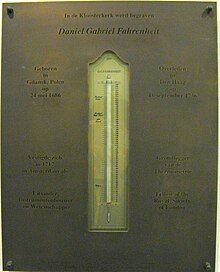German physicist (1686–1736)
Possibly owing to a business failure, Fahrenheit emigrated to Amsterdam from his native Danzig (now Gdańsk in Poland) to become a glass blower and instrument maker. He specialized in the making of meteorological instruments, and proceeded to develop a reliable and accurate thermometer. Galileo had invented the thermometer in about 1600, using changes in air volume as an indicator. Since the volume of air also varied considerably with changes in atmospheric pressure liquids of various kinds were quickly substituted. Fahrenheit was the first to use mercury in 1714. He fixed his zero point by using the freezing point of a mixture of ice and salt as this gave him the lowest temperature he could reach. His other fixed point was taken from the temperature of the human body, which he put at 96°. Given these two fixed points the freezing and boiling points of water then work out at the familiar 32° and 212°. One advantage of the system is that, for most ordinary purposes, negative degrees are rarely needed.
Using his thermometer, Fahrenheit measured the boiling point of various liquids and found that each had a characteristic boiling point, which changed with changes in atmospheric pressure.
丹尼爾·加布里埃爾·華倫海特(Daniel Gabriel Fahrenheit, 1686年5月14日-1736年9月16日),德國物理學家、工程師(雖然他基本定居在荷蘭),華氏溫標的創立者。
華倫海特出生於但澤(今波蘭格但斯克),少年時其父母意外死亡,迫使華倫海特開始學習商業。經過在阿姆斯特丹的多年訓練後,他定居海牙,從事玻璃製品的吹制和貿易,並製作氣壓計、高度計和溫度計出售,先後研製成功酒精和水銀溫度計。1718年後,他在阿姆斯特丹教授物理學,1724年,他成為英國皇家學會院士。華倫海特在物理學歷史上首次確認了每一種液體的沸點都大體一致,但會隨著氣壓的改變而改變,氣壓越大,沸點越高,並以此原理發明了沸點高度計。[1]
在製作溫度計的過程中,華倫海特必須尋找一種對溫度進行精確標記的方法,於是他採用了三種在當時技術條件下十分重要的溫度作為標記刻度的依據。首先,他將水、冰和氯化銨混合,達到了當時所能記錄到的最低溫度[2],將其定為0度。然後他又將水的冰點定為32度,最後將人的體溫定為96度。
不久,在採用能承受更高溫度的水銀溫度計後,華倫海特改將水的沸點作為溫度計的上限,定為212度[3],這樣,他可以將水的冰點和沸點之間劃分為180度,同時又使得人體體溫接近100這個整數。在攝氏溫標被廣泛接受之前,華氏溫標是最被人接受的溫度量度。時至今日,美國人仍然在日常生活中使用華氏溫標,在英國等地已逐漸棄用。


沒有留言:
張貼留言